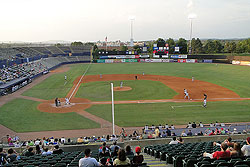
|
The 1980s may have been a creative and colorful decade, but it was the minors' least imaginative 10-year period of ballpark construction and Joe W. Davis Municipal Stadium is a relic of that not so long ago era.
Generally referred to as Joe Davis Stadium and often by its nickname, “The Joe,” the place where the Stars play is a mesh of exposed aluminum, chain link and concrete. That’s definitely not an attractive trio, but most seats have a pleasing backdrop as the stadium looks out upon the city's hilly terrain and the trees that surround it. The presence of lush green trees on stadium property is the saving grace of The Joe’s overwhelmingly lackluster exterior. The façade is comprised of aluminum siding, but much of it is obscured by the trees that line the outside of the stadium, specifically running parallel to the baselines. What qualifies as a poor man’s plaza fronts the stadium, but it merely contains a mostly unlandscaped patch of grass surrounded by a sea of concrete, which is a harbinger of things to come upon entrance. All fans enter the stadium directly behind home plate, where the sole sets of tickets windows flank the glass-walled suite entrance. With the exception of those glass panes and the concrete cinder blocks used for the box offices, the rest of the stadium’s perimeter is formed by barbed wire topped chain link fencing. Attached to the chain link fences near the two entrances adjacent to each box office are banners listing the stadium’s rules in a space age font. The same futuristic font is used inside of the stadium, including on section number signage, and is the only real tribute to the team’s nickname, which was derived from Huntsville’s strong association with NASA. “Huntsville has been important in developing space technology since the 1950s,” boasts the Alabama city’s Convention & Visitors Bureau and indeed the nearby Marshall Space Flight Center has played a vital role in NASA’s history and success. Upon passage through the stadium’s turnstiles, where tickets are still torn instead of scanned, fans enter a covered concourse that’s behind and underneath the upper portion of the grandstand. The concourse gives fans their first taste of the omnipresent exposed concrete that is a hallmark of Joe Davis Stadium. Most concessions line the third base side of the concourse, where the air conditioner units that are atop the corresponding third base grandstand are noticeable because of the water the drips from them onto the uncovered portion of the concourse that is behind the portable food carts. In a sign of the times in which the stadium was built, the clubhouses for each team are accessible via the concourse. Doors for each clubhouse are clearly visible to passerby’s on the concourse’s first base side (visitor’s) and well beyond the concession stands on the third base side (Stars). Entrance portals for the good seats – those behind and nearest home plate – have been painted by local artists in association with the Murals to Promote Community Awareness (MPCA) project, which Huntsville-based artist Mellissa Meeks began in 2008 in conjunction with the Stars to help spruce up the stadium’s previously drab entryways by painting murals upon their walls that promote local non-profit organizations. The portals that lack murals are painted solid blue, as are all other walls within the grandstand, which extends from where dirt meets grass behind first base to even with the left field foul pole.
There are a few thousand chairs, all painted green, within the portion of the grandstand that surrounds the infield, but it’s hard not to notice the sea of silver aluminum benches and the grey concrete slabs beneath them. Just three bleacher sections are on the stadium’s abbreviated first base side. The other 21 bleacher only sections begin at or just past the home team dugout on the third base side of the stadium and continue until the grandstand ends where fair territory of left field begins. There is an immense amount of foul territory at Joe Davis Stadium and there’s a perfectly good reason for it: Huntsville’s municipal stadium was designed to be a multi-purpose one. Hence a seating bowl that extends the entire length of a football gridiron and a playing field wide enough to accommodate a field for that sport, which reins supreme in comparison to others sports more so in Alabama than any other state. More foul territory means seats that are further away from the field than normal and that also affects fans in the stadium’s suites, which even the most optimistic ticket sales associate would be hard pressed to deem as luxurious. Located only on the third base side of the stadium, the Stars refer to them as “air-conditioned skyboxes” and have 14 of them to try to fill each game. Eleven of the skyboxes are designated as “small” and can seat 10, two are “large” and can hold 15, and one is referred to as “extra large” because its capacity is 25+. The extra large skybox was also the press box for football games. Note the word “was,” as The Joe is now a baseball-only facility. As the team notes, the suites are all air-conditioned. But what’s not mentioned is that there’s nowhere for the cool air to escape, as suite holders are forced to watch the game from behind Plexiglas windows that don’t open. The stadium’s suite level is also responsible for the unfinished in appearance look that results from where suites – or something – should be above the first base concourse. Instead there is nothing but empty space that’s blocked off by a chain link fence, which remains as common a sight inside of The Joe as it is elsewhere on stadium property. Most notably, chain link fencing is used in place of a retaining wall behind the last row of seating in every 200-level section that’s not in front of the press box or suites. Further adding to the unfinished feel, the green chair-filled upper portion of the grandstand that surrounds the infield is missing seats from its last two rows, although that’s not necessarily a bad thing as it provides plenty of good standing room space in a place you normally don’t find it. So I’d consider it an unusual, yet useful design defect.
On each side of the scoreboard star-shaped rotating billboards display their various procession of ads and, as is the case at all minor league ballparks, the outfield walls at Joe Davis Stadium are completely plastered with a variety of advertisements. Just like at most minor league parks, Joe Davis Stadium has another wall directly behind the outfield wall. The secondary wall’s purpose is to display more ads.
Next to the paid for placement banners draped over the secondary wall in right field is one dedicated to Don Mincher, who was born in Huntsville and had a 13-year major league career, during which time he hit 200 home runs in 1,400 games. Upon returning to Huntsville after retiring as a player, he opened a sporting goods store.
In Mincher’s inaugural year as Stars GM the team won the Southern League championship, a feat that was repeated during Mincher’s first and final year as Stars owner. Star-shaped markers of the team’s three championship seasons are plastered upon a weather-beaten wall next to the left field foul pole. That wall and a similar one in right field are the third and final tier of outfield billboards at the stadium where weathered is an apt description. Joe Davis Stadium is one of the most poorly maintained ballparks at which I've ever seen a game, which helps to explain why the video board, installed in 2004, wasn't working during my visit six years after Texas Star Solutions installed it. In another ominous sign of a ballpark operated on the cheap, the lights were turned on just prior to the 7:00 game on the evening of my visit. Furthermore, all seats within the expansive grandstand are sold as general admission, a policy that began in 2010. The reason? The stadium's phone lines - which are original - went down on a 4th of July homestand in 2009, making it impossible for the box office to connect to their online ticketing system, thereby making it impossible for assigned seat tickets to be printed. Rather than fix the problem all tickets are now pre-printed, with a date stamped on upon purchase. Compared to those problems at the city-owned stadium, the partially correct functioning clock on the façade beneath the press box is a minor issue. The clock, which is atop section 221, isn't even right twice a day in regards to time, but accurately displays the temperature and humidity for anybody that happens to notice it. Upon the same wall one section (220) over from the clock, the words “Horn Free Section” are written. In the same space age font, section 215 is designated as alcohol free. The team shop behind home plate is the only thing that looks or feels modern within the stadium. It was a 2009 mid-season addition, but is a tad on the smallish side. Nonetheless, it’s an air-condition improvement over the previous open-air version. In the odds and ends department, Joe Davis Stadium has a handful of wooden and plastic picnic tables scattered about its cross aisle in left field, which is near where a wood drink rail sprouts up within a pair of bleacher sections. Dozens of wooden picnic tables are under canopy cover down the right field line, where the foul territory drastically curves inward to accommodate the party tent. Near the pre-game party area is the visitor’s bullpen, where fans can stand directly behind the sitting pitchers if they so desire. By design, the Stars’ bullpen down the third base line is also not restrictive, but fans are now prevented from sitting in the first row of bleachers behind it as yellow caution tape – the crime scene kind – has been tackily attached to a pair of orange cones in row 1 of section 108, thus keeping fans at bay or away from where Huntsville’s relievers watch the game. While the stadium lacks a berm, there is a grassy hillside behind its outfield walls where freeloading fans can see a good portion of the playing field if they stand behind the gaps that exist between the scoreboard and the star-shaped billboards that flank it.
With a born on date of 1985, Joe Davis Stadium is the oldest venue in the Southern League. While the time period in which it was built is partly to blame for its bland and boring appearance, The Joe’s deficient in design confines have become as weathered as they are outdated in the time that has elapsed since it was built. And less and less people are noticing as a result. It took 25 seasons, but the Stars’ attendance hit rock bottom in the 10 team Southern League in 2009, when for the first time less than 100,000 fans saw them play in the stadium that drew a record 300,810 in its inaugural year. The attendance drop off from year one was predictably gradual, but only once prior to 2002 did the Stars fail to draw at least 200,000 fans. Since 2003, only once have they surpassed that mark and the 93,845 paying customers in 2009 marked the first time in team history that the Stars had finished dead last in the league in total attendance. "This is a very apathetic baseball town, and something's going to have to change," said Gord Ash, the assistant general manager of the Stars' parent club, the Milwaukee Brewers, after watching a game in Huntsville attended by just 660 fans during the summer of 2009. "They're going to be sorry in a couple of years when they don't have baseball. I don't know if they're going to lose the team, but they're going to lose our interest in being here because there's no enthusiasm," Ash concluded during his visit. While the Stars’ are in no danger or leaving Huntsville anytime soon thanks to a lease that runs through 2015, their long-term future in Alabama’s fourth largest city almost assuredly depends on a new ballpark being built, and “ballpark” is the key word as Joe Davis is undoubtedly more of a “stadium” than a “ballpark.” That doesn’t necessarily make Joe Davis Stadium bad, but it sure as heck isn’t modern and in a city that rightfully prides itself as being a pioneer in America’s space exploration efforts Huntsville’s home for America’s pastime is light years behind most of its peers.
Location and ParkingJoe Davis Stadium is a short distance south of downtown Huntsville and the interstate, I-565, that passes through it. The stadium is accessible from Highway 231 (Memorial Parkway) and is nestled amongst various businesses so that it remains somewhat hidden in a very active area. Although bordered on three of its sides by an 18-screen movie theatre, grocery store and ice rink complex, the stadium’s more noticeable neighbors are light industrial in nature and line the road (Leeman Ferry) that leads to Joe Davis Stadium. Examples of such businesses include public storage units, auto body shops, a military surplus store, and numerous single story office parks, which are in the shadows of the stadium. Huntsville is found at the foothills of the Appalachian Mountains and the horseshoe-shaped Monte Sano Mountain range is the stadium’s predominant backdrop, although the Taj Mahal-looking dome structure that effectively calls attention to the nearby Parkway Place Mall can be glimpsed beyond left field. Plenty of paid parking is available on stadium grounds. The lots near the stadium are paved, although grass has grown in cracks throughout much of their asphalt. The overflow lots are not often needed, but anyone who parks in them does so on gravel.
Stadium HistoryIn the summer of 1984, Larry Schmittou approached the Huntsville City Council about the possibility of moving one of his minor league teams to their town. Schmittou had recently purchased the Triple-A Evansville Triplets and decided to move them to Nashville, where he already owned the Double-A Sounds. That meant he needed to find a southern city where he could relocate his Southern League franchise and on August 3, 1984 that pursuit brought him to Northern Alabama for a face-to-face meeting with members of Huntsville’s city council. Schmittou told the council that he would likely move his Double-A team to Huntsville if the city were to construct a stadium for them and, just as importantly, allow beer to be sold during their games. Six days later, the council was willing to meet Schmittou halfway. They were in favor of building a multi-purpose stadium but, being in the Bible Belt, beer sales were a problem and after listening to protestations from several ministers the council decided that alcohol could not be served in any stadium the city would build. Schmittou was already on record as saying “if we don’t have beer, we don’t come,” and Huntsville mayor Joe Davis conceded that the council’s no beer decision meant no team for the city over which he governed. "I guess it's over," said Davis, after a counteroffer he made to Schmittou on August 10 was rejected. That offer, as reported in The Tuscaloosa News, called for the team to “come here for at least one year without a beer license,” during which time they would be financially compensated for the loss of beer sales. Despite the mayor’s dour proclamation, negotiations persisted and two weeks after the city council said beer couldn’t be sold at the proposed stadium they revised their position to beer couldn’t be sold in all sections of the stadium.
Joe W. Davis Municipal Stadium opened on the evening of April 19, 1985, when a near capacity crowd watched the new hometown team christen Huntsville’s new stadium with a 10-0 shutout of the Birmingham Barons. The Stars’ Ray Thoma recorded the stadium’s first hit, an inside-the-park homer to center field that started off as a single before the ball took a “tricky bounce” on the still unsettled sod and rolled to the fence. Future major leaguer Charlie O’Brien was the first to actually clear the outfield fence, hitting a homer to left field in the second inning. Later in the game, future superstar Jose Canseco hit a grand slam. The stadium was designed to host multiple sports, such as football and soccer, and events, like concerts, but its first major non-Stars usage was for a baseball game played with aluminum bats, as that’s what the college kids swing, and the Universities of Alabama and Tennessee brought their metal “lumber” to Joe Davis Stadium just ten days after it opened, with the Crimson Tide rolling to a 7-4 win before 5,210 fans on April 29, 1985. College baseball games have been a common occurrence at Joe Davis Stadium. An NCAA regional baseball tournament was played there in 1987 with 9,953 fans attending 11 sessions of the double-elimination tourney that featured Arkansas, Auburn, Clemson, Middle Tennessee State, Seton Hall and West Virginia. The Razorbacks won the regional to advance to the College World Series in Omaha. The University of Alabama at Huntsville began a baseball program in 1996 and ever since they have played their home games at Joe Davis Stadium, which has also hosted college football games and plenty more of the high school variety until the pigskin stopped flying there in the fall a while ago. Keeping the Stars in town is the stadium’s primary purpose now, but given its charmless multi-purpose design and lack of modern amenities the team refused to extend its lease with the city when it ran out after the 2003 season. It wasn’t until the city agreed to spend $1 million on improvements that the Stars’ New York-based owner, Miles Prentice, finally signed a five-year lease (with a five-year renewal option) in 2006 to keep the team in Huntsville. When that lease was signed, the stadium’s lighting system did not meet Double-A standards, which made them an obvious target for the capital improvements paid for by the city. Besides the lights, the Stars’ clubhouse was remodeled, while the most visible change to the stadium was the application of blue paint to its ubiquitous exposed concrete walls. And before any of those changes took place, the blue (lower) and red (upper) chair-back seats in the grandstand were replaced with seats of a uniform color (green). On April 14, 2010, Prentice announced that he exercised the five-year renewal option to keep the Stars playing at Joe Davis Stadium through the 2015 season, although the renewal is seen more as a commitment to keep the team in Huntsville than it is to keep the Stars at the only home they’ve ever had. After meeting with Mayor Tommy Battle on July 24, 2009, Prentice commented that there was an agreed upon "recognition that we in Huntsville need a new ballpark." After signing the five-year extension in 2010 the owner acknowledged it was done in part to remove the pressure of having a too soon deadline for the city to be able to accommodate what had been recognized the summer before. Prentice has used the patient approach in the past at the Double-A level to get a new ballpark built, as was the case for his Midland RockHounds franchise in 2002, but he is also on record as saying a renovation might be acceptable, and to that end he has already enlisted architectural firms to study the feasibility of a major overhaul at Joe Davis Stadium. Regardless of whether the Stars eventually get a new ballpark or a substantially renovated version of what exits, one thing is certain: the days of Joe Davis Stadium as is are numbered.

Joe Davis Stadium Facts, Figures, Firsts & FootnotesOther stadium firsts (all of which occurred on 4/19/85):
| |||||||||||||||||||||||||||||||||||||||||||||||||||||||


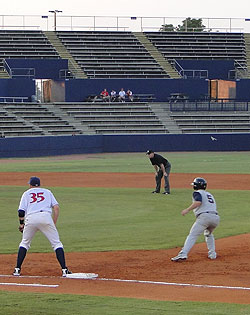 The larger than necessary grandstand is perhaps the stadium’s signature feature, as it can hold 10,200 fans in two levels that are split by a wide cross aisle. More rows are above the cross aisle (up to 14) than below it (up to 10), but all seats are uncovered and the majority of them are on backless bleachers.
The larger than necessary grandstand is perhaps the stadium’s signature feature, as it can hold 10,200 fans in two levels that are split by a wide cross aisle. More rows are above the cross aisle (up to 14) than below it (up to 10), but all seats are uncovered and the majority of them are on backless bleachers.
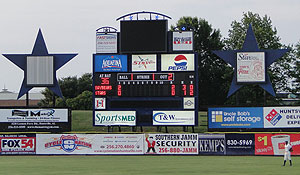 Equally unusual but far less pleasing, most seats in the last three sections (201-203) of the upper grandstand – those that are found in the left field corner - have no view of the stadium’s sole scoreboard, which stands in left-center field. The scoreboard is a fairly standard sized 36' x 48' and centered atop it is a 12' x 18' video board.
Equally unusual but far less pleasing, most seats in the last three sections (201-203) of the upper grandstand – those that are found in the left field corner - have no view of the stadium’s sole scoreboard, which stands in left-center field. The scoreboard is a fairly standard sized 36' x 48' and centered atop it is a 12' x 18' video board.
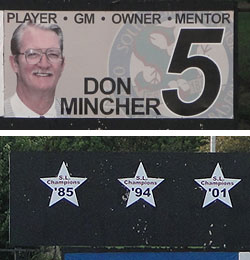 When the Stars moved to Mincher's hometown in 1985 he was named the team's first general manager. Nine years later he became part-owner of the team, which was sold in 2001 to current owner Miles Prentice so that Mincher could focus on his position as president of the Southern League, a post he ascended to on an interim basis in 2000 before he was named the permanent president the following year. Mincher wore #5 during the majority of his major league playing days so that's the number the Stars retired in his honor on June 6, 2008, when the team unveiled a banner adjacent to the right field foul pole in a number retirement ceremony before a game against the West Tenn Diamond Jaxx. Above a bespeckled picture of Mincher on the banner are the words “Player * GM * Owner * Mentor” and next to his name is a large number five, which is the only number retired in team history.
When the Stars moved to Mincher's hometown in 1985 he was named the team's first general manager. Nine years later he became part-owner of the team, which was sold in 2001 to current owner Miles Prentice so that Mincher could focus on his position as president of the Southern League, a post he ascended to on an interim basis in 2000 before he was named the permanent president the following year. Mincher wore #5 during the majority of his major league playing days so that's the number the Stars retired in his honor on June 6, 2008, when the team unveiled a banner adjacent to the right field foul pole in a number retirement ceremony before a game against the West Tenn Diamond Jaxx. Above a bespeckled picture of Mincher on the banner are the words “Player * GM * Owner * Mentor” and next to his name is a large number five, which is the only number retired in team history.
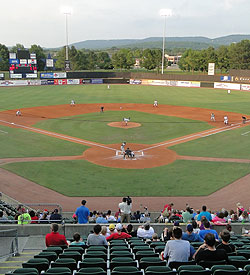 Worth the price of admission are the views of the Monte Sano Mountain that fills in the stadium’s backdrop. Rising only about 1,600 feet above sea level, the mountain range looks more like a small ring of tree-covered hills from within the stadium, where it can easily be seen from any seat.
Worth the price of admission are the views of the Monte Sano Mountain that fills in the stadium’s backdrop. Rising only about 1,600 feet above sea level, the mountain range looks more like a small ring of tree-covered hills from within the stadium, where it can easily be seen from any seat.

